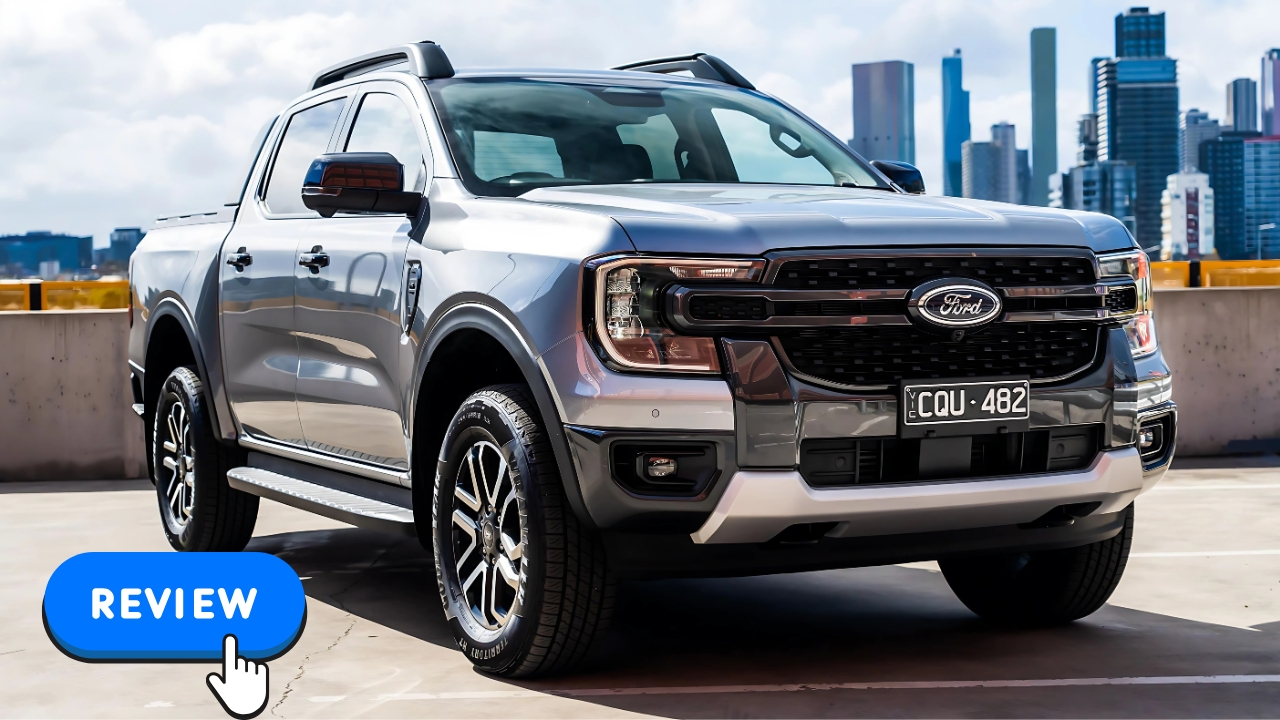2025 Ford Ranger Sport V6: The midsize pickup truck segment has never been more competitive, and Ford’s answer to this challenge comes in the form of the redesigned 2025 Ranger.
This isn’t just another incremental update – Ford has fundamentally reimagined what a midsize truck should be, particularly with the introduction of their optional twin-turbo V6 engine that transforms the Ranger from a capable workhorse into a genuine performance machine.
The Heart of the Beast: Engine Options That Deliver
Standard 2.3L EcoBoost Foundation
The 2025 Ford Ranger comes standard with a turbocharged 2.3-liter four-cylinder engine that produces 270 horsepower and 310 lb-ft of torque. This isn’t your grandfather’s underpowered truck engine – it’s a sophisticated powerplant that delivers meaningful performance for daily driving and work applications. The engine pairs with Ford’s proven 10-speed automatic transmission, creating smooth power delivery whether you’re navigating city traffic or pulling a trailer.
What makes this engine particularly compelling is its real-world usability. At the Edmunds test track, a four-wheel-drive Ranger Lariat accelerated from zero to 60 mph in a quick 6.7 seconds, significantly outpacing comparable competitors like the Toyota Tacoma. This performance advantage becomes evident in everyday scenarios – merging onto highways, passing slower traffic, or simply feeling confident behind the wheel.
The Game-Changing 2.7L Twin-Turbo V6
For buyers seeking additional capability, Ford offers an optional turbocharged 2.7-liter V6 that generates 315 horsepower and 400 lb-ft of torque. This engine represents a significant step up in performance and sophistication, positioning the Ranger as a serious alternative to full-size trucks for many buyers.
The V6’s additional power becomes most apparent under load. Whether you’re towing a boat to the lake, hauling materials for a weekend project, or simply want that extra confidence when fully loaded, the twin-turbo V6 delivers the goods. The engine’s broad torque curve means power is available across a wide RPM range, making it equally comfortable cruising at highway speeds or working hard in low-speed scenarios.
Design Philosophy: Function Meets Modern Aesthetics
Exterior Styling That Commands Attention
For 2025, Ford has introduced three striking new exterior color options: Ruby Red Metallic, Desert Sand, and Marsh Gray, giving buyers fresh ways to personalize their Ranger. The design language clearly draws inspiration from the full-size F-150, creating a family resemblance that reinforces Ford’s truck heritage while establishing the Ranger’s unique identity.
The Sport trim comes equipped with LED projector headlamps, a power-sliding rear window, and rides on 18-inch wheels. These details matter – they transform the Ranger from a purely utilitarian vehicle into something you’d be proud to park in any driveway. The LED lighting technology provides superior illumination while contributing to the truck’s modern appearance.
Interior Refinement That Surprises
Step inside the 2025 Ranger, and you’ll immediately notice Ford’s commitment to modernizing the midsize truck experience. The cabin features a digital gauge display, textured dashboard trim, and honeycomb-patterned air vents that create a contemporary atmosphere previously reserved for more expensive vehicles.
Storage solutions demonstrate thoughtful engineering throughout the cabin. Ford has incorporated a hidden upper glovebox in the dashboard, large door pocket cubbies, and storage located under the truck’s rear seat. These practical touches acknowledge that truck buyers need places to stow everything from work gloves to charging cables to important documents.
The only body style available is the SuperCrew crew cab, which features four doors with seating for five. This decision reflects market realities – modern truck buyers prioritize passenger space and daily usability over multiple cab configurations.
Technology Integration: Keeping Pace With Expectations
Infotainment and Connectivity
A 10.1-inch infotainment display comes standard, but buyers with a focus on technology can upgrade to an even bigger, vertically oriented 12-inch screen. The larger display provides enhanced functionality and improved visibility for navigation, entertainment, and vehicle settings.
The standard SYNC 4 system with an intuitive touchscreen interface offers seamless smartphone integration via Apple CarPlay and Android Auto. Ford understands that connectivity isn’t optional in today’s market – it’s fundamental to the ownership experience. Available features like wireless charging and premium audio systems elevate the daily experience without overwhelming users with unnecessary complexity.
Safety Technology That Protects
Ford Co-Pilot360 includes adaptive cruise control, lane-keeping assist, and a rearview camera, ensuring peace of mind on every journey. These systems work together to reduce driver fatigue and enhance safety during both daily commuting and long-distance travel.
The Technology package adds adaptive cruise control, a 360-degree camera system, and front parking sensors for buyers who want comprehensive driver assistance technology. The 360-degree camera system proves particularly valuable when maneuvering in tight spaces or navigating off-road terrain where visibility is compromised.
Capability That Validates the Choice
Towing and Payload Performance
The 2025 Ranger delivers towing capacity of up to 7,500 pounds, positioning it competitively within the midsize truck segment. This capability covers the vast majority of recreational and work-related towing needs, from boats and campers to utility trailers and equipment haulers.
Ford redesigned the Ranger just last year, giving it an all-new design inside and out, loads of available tech, an available turbocharged V6 engine and a new Ranger Raptor version. This comprehensive redesign ensures the Ranger isn’t simply refreshed – it’s rebuilt from the ground up to compete effectively against increasingly sophisticated competitors.
b
The available FX4 Off-Road Package accelerates capability beyond the pavement. Ford recognizes that many truck buyers want genuine off-road capability, not just the appearance of ruggedness. The FX4 package includes hardware and software modifications that enable confident exploration of unpaved terrain.
The outboard-mounted rear shocks and an independent front suspension help absorb some of the harshest off-road conditions. This suspension design represents sophisticated engineering that balances on-road comfort with off-road capability – a challenging compromise that Ford has executed successfully.
Market Position and Value Proposition
Pricing Strategy That Makes Sense
The price of the 2025 Ford Ranger starts at $35,025 and goes up to $45,810 depending on the trim and options. This pricing structure positions the Ranger competitively against established rivals while providing clear value progression through the trim levels.
The midrange XLT represents the best value within the Ranger lineup, offering reasonable pricing with features most truck buyers need. The XLT strikes an intelligent balance between essential features and unnecessary luxury, making it the logical choice for buyers seeking maximum value.
Competitive Landscape Reality
The Ranger’s chief rivals – including the Chevrolet Colorado, GMC Canyon, and Toyota Tacoma – have all seen similar updates recently, intensifying competition within the midsize truck segment. This competitive pressure benefits consumers by forcing manufacturers to deliver genuine improvements rather than cosmetic changes.
Technical Specifications Overview
| Specification | 2.3L EcoBoost | 2.7L Twin-Turbo V6 |
|---|---|---|
| Engine Type | Turbocharged I4 | Twin-Turbocharged V6 |
| Displacement | 2.3 Liters | 2.7 Liters |
| Horsepower | 270 hp | 315 hp |
| Torque | 310 lb-ft | 400 lb-ft |
| Transmission | 10-Speed Automatic | 10-Speed Automatic |
| Drivetrain | RWD/4WD Available | RWD/4WD Available |
| Towing Capacity | Up to 7,500 lbs | Up to 7,500 lbs |
| Bed Length | 5 feet | 5 feet |
| Seating | 5 passengers | 5 passengers |
| Starting Price | $35,025 | Available on XLT+ |
Ownership Experience Considerations
Daily Usability Factors
Compared to the F-150, the Ranger is easier to drive and less expensive while maintaining a maximum towing capacity of 7,500 pounds to pull most of the trailers and boats that people actually use. This positioning acknowledges that many buyers want truck capability without full-size truck compromises in terms of maneuverability, parking, and fuel consumption.
The Ranger drives well for a compact truck, remaining quiet and composed even on twisty roads and over bumps, with the ride being especially impressive with nothing in the cargo bed. This refinement level distinguishes the Ranger from more utilitarian competitors that prioritize capability over comfort.
Long-Term Value Retention
Ford’s investment in redesigning the Ranger demonstrates commitment to the midsize truck segment. The comprehensive nature of the updates – including new engines, technology, and design – positions the 2025 model as a long-term platform rather than a short-term solution. This approach typically translates to better residual values and longer model lifecycles.
The Raptor Alternative
For buyers seeking maximum performance, the Ranger Raptor gets a turbocharged 3.0-liter V6 making 405 horsepower and 430 lb-ft of torque, along with a slew of off-road and interior upgrades. The Raptor represents Ford’s high-performance answer to buyers who want serious off-road capability combined with impressive on-road performance.
The 2025 Ranger Raptor is built to be taken off-road, equipped with a 3.0L V6 EcoBoost engine to crush the dunes with purpose-built suspension boasting a wider track width and more ground clearance. This specialized variant validates Ford’s commitment to covering the entire performance spectrum within the Ranger lineup.
A Mature Evolution
The 2025 Ford Ranger Sport V6 represents thoughtful evolution rather than revolutionary change. Ford has identified the key areas where the previous generation fell short and addressed them systematically. The result is a midsize truck that doesn’t apologize for its size while delivering capability that satisfies the vast majority of truck buyers’ actual needs.
The optional twin-turbo V6 engine transforms the Ranger’s character, providing performance that rivals larger trucks while maintaining the maneuverability advantages of a midsize platform. Combined with modern technology, refined interiors, and competitive pricing, the 2025 Ranger positions itself as a compelling alternative to both smaller and larger trucks.
For buyers seeking the sweet spot between capability and practicality, the 2025 Ford Ranger Sport V6 delivers exactly what its name promises – power that meets practicality in a package that makes sense for modern truck buyers.
Frequently Asked Questions
Q: What’s the difference between the 2.3L and 2.7L engines? A: The 2.7L twin-turbo V6 produces 45 more horsepower and 90 more lb-ft of torque compared to the standard 2.3L four-cylinder, providing noticeably stronger acceleration and towing performance.
Q: Can the Ranger tow as much as a full-size truck? A: The Ranger’s 7,500-pound towing capacity covers most recreational and work trailers, though full-size trucks typically offer 10,000+ pound capacities for heavier applications.
Q: Is the V6 engine worth the extra cost? A: The V6 provides meaningful performance improvements, particularly for towing and acceleration, making it worthwhile for buyers who regularly use their truck’s full capability.
Q: How does the Ranger compare to the Toyota Tacoma? A: The Ranger offers more power, faster acceleration, and newer technology compared to the Tacoma, while the Tacoma traditionally holds its value better over time.
Q: What trim level offers the best value? A: The XLT trim provides the optimal balance of features and pricing, including essential technology and comfort features without luxury trim premium pricing.
ALSO READ: Top 2025 Hybrid Picks for Budget-Savvy Drivers

